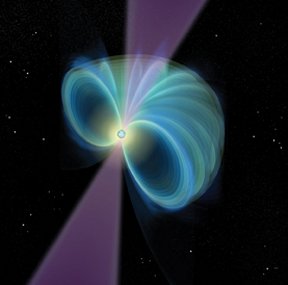Astronomers say that they have discovered a new class of star that emits a burst of radio waves for 2 to 30 milliseconds before falling silent for minutes to hours. Each of the 11 newfound objects ranks among the strongest known sources of radio waves in the universe.

Because the objects broadcast for only about a tenth of a second each day, they’re extraordinarily difficult to detect. The Milky Way may harbor several hundred thousand of these elusive stars, Andrew G. Lyne of the University of Manchester in England and his colleagues report in the Feb. 16 Nature.
That estimate would make these stars two to three times as numerous as the relatively common stars called radio pulsars. Ultracompact neutron stars, they produce regular pulses of radio waves as they rotate. The newfound objects, dubbed rotating radio transients (RRATs), may be cousins of the radio pulsars, the discovery team suggests.
The researchers initially detected isolated bursts of radio emissions using data from the wide-field Parkes Radio Telescope in New South Wales, Australia. They then searched for patterns in the arrival times of the signals and calculated that 10 of the 11 stars have a rotation period of 0.4 to 7 seconds.
However, the stars emit radio waves only during a few of those rotations. “It’s as if, following [a burst], a RRAT has to gather its strength for perhaps a thousand rotations before it can do it again,” says Lyne.
The rotation rate and intermittent release of radio waves suggests that these stars are neutron stars but not radio pulsars, which emit regular, frequent pulses.
Although the team may have uncovered a new kind of neutron star, theorist Robert Duncan of the University of Texas at Austin says that “a more reliable and conservative interpretation” is that the researchers have detected elderly rotating neutron stars—either radio pulsars or magnetars, which have the strongest known magnetic fields of any star.
Theorist Maxim Lyutikov of the University of British Columbia in Vancouver concurs, noting that radio pulsars generate weaker electric fields as they age and therefore fewer radio waves.
In separate research, Lyne and other colleagues report online (http://xxx.lanl.gov/abs/astro-ph/0512379) that they identified X-ray emissions from one of the RRATs. The weakness of the X rays, along with the star’s unusually strong magnetic field, suggests that the RRAT may be an old, inactive magnetar, Duncan says.
This star and at least two other RRATs are slowing their spins, further suggesting that they might be old radio pulsars or fading magnetars, Duncan notes.
With the results so new, “it will take time—and more data—to gain a full understanding,” he adds.







